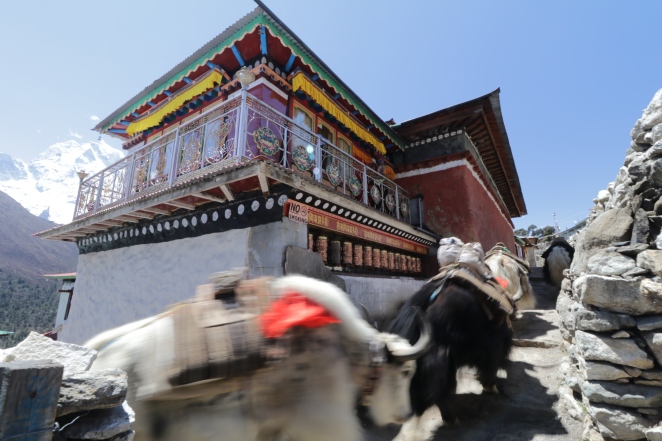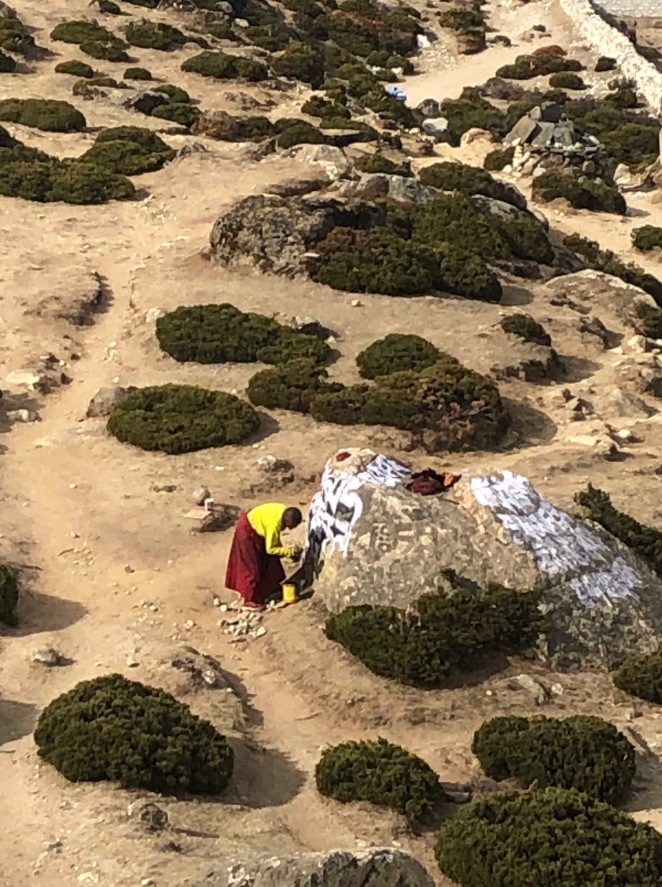Phortse (11,960′) to Dingboche (14,460′)
Stats: 8.2 miles. 2,500′ elevation difference but 3,100′ overall gain.
Morning air is crisp. I zip my jacket and slip fingers into light gloves as we pick our way uphill without a clear path. The sky is such an impossible shade of deep blue and soaring Khangega (22,251′) and Thamserku (21,729′) glimmer with frozen ice. I stop; my soul fills with wonder. Observe the majesty placed before you. Be a witness to the power of life.
Moving along a ridgeline, mountains and valleys are tightly stacked like accordian pleats–an impossible arrangement of towering rock, ice and running water in the deepest folds.
Eagles ride the thermals overhead and I never tire of their majestic presence or the symbol they represent.
The sun rises higher, infusing sudden warmth resulting in a stop to strip off layers. Our porters and guides rest. We encourage them to sit close for a photo, a lasting image of our appreciation for such hard work. They are a congenial bunch of rascals–always ready with laughter and teasing each other. We are living in this single moment, feeling joy and peace in our companionship.
Passing stupas and mani stones, I wonder how different the United States would be if physical reminders to pray or meditate were allowed. Daily intentions for loving others, empathy for all, or expressions of gratitude are the foundation of humanity and in short supply.
Above Pangboche, sweeping views unfold. My steps quicken and the warm sun eases the overnight chill still lingering in my bones. At our rest spot, I slide out of my backpack, choosing a table with a clear view of the monastery next door.

photo courtesy of Michael Chiechi
Respite is short-lived. A Yak team decked out in jingling bells heads uphill and I’m struck with a feeling of deja-vu. Time blurs the lines of past centuries with present time.  This monastery is the oldest in the Everest region. It’s expostulated that Lama Dorjee flew over the highest mountains and landed here on a boulder. That rock with the impression of his feet rests inside this holy place. But the intriguing icons are the Yeti skull and hand. A finger was stolen in the 1950’s and the rest of the hand disappeared in the 1990’s. Foreigners appear to be responsible for the crime. In 2011, remains of the robbed finger were tested in London with human DNA and is of Asian genome. Photography isn’t allowed in any temple but trust me, that Yeti skull is bizzare and a fake replacement hand lays palm down in the same glass reliquary.
This monastery is the oldest in the Everest region. It’s expostulated that Lama Dorjee flew over the highest mountains and landed here on a boulder. That rock with the impression of his feet rests inside this holy place. But the intriguing icons are the Yeti skull and hand. A finger was stolen in the 1950’s and the rest of the hand disappeared in the 1990’s. Foreigners appear to be responsible for the crime. In 2011, remains of the robbed finger were tested in London with human DNA and is of Asian genome. Photography isn’t allowed in any temple but trust me, that Yeti skull is bizzare and a fake replacement hand lays palm down in the same glass reliquary.
Leaving Pangboche, we walk across an arid plain with boulders thrown about as if giants had a bowling tournamet, leaving smashed pins and balls all over the place. The walk is easy with strings of colorful trekkers heading in opposite directions before we drop to the river and cross a bridge again. Breathing hard uphill, we run into two young children collecting yak dung. This will be dried and used as fuel and perhaps bartered for other supplies.
Pemba is in front of me and I ask, “Why aren’t they in school?”
He shakes his head. “Probably don’t go to school. It costs too much and unless a child has a sponser, they’ll never receive an education.” He recounts how his father got him a job as an expedition porter when he was 13 so that he could pay for his studies. Many children in Nepal work physically demanding jobs and are lucky if they have a fourth grade education. I recently overheard Pemba tell a fourteen-year-old porter, “you need to go to school or you won’t have a good life.”
The girl who stands before me has feces smeared across her hands and face. No crystal ball required to devine that bleak future. My heart flutters. “And these kids have to work?” Pemba nods his head. It’s not unusual to see children working with their familes in Nepal. But these youngsters are without adult supervision. Emotionally, I shut down and can’t take a picture. Thankfully, Lise captured the moment when Pemba sat to chat with them. Every day I see this man treat others with kindness and compassion.
Reeling, I contemplate this experience as we climb higher and later arrive above Dingboche. I want to share these thoughts with Pemba: We all agree that school is important. But how do you keep young people–your greatest treasure– from leaving Nepal to work in foreign lands? I’ve seen this before in countries where villages are comprised of only old people. Who gets an education cannot be based on gender, but on the candidate showing the greatest ability. Women make up 2/3 of the world’s illiterate people (UN headquarters statistic). Images of brilliant women throughout time flash into my mind. Marie Curie, Florence Nightingale, Ada Lovelace; an endless list with names still purcolating through the mud of buried history . Their educations changed the world.
Below me, a monk paints a prayer onto a boulder.  I watch the brush move up and down and breathe my own prayer into his mind and hand: Education for all children. Passing him, we arrive at Dingbouche’s stupa and the village beyond. Today’s glorious walk has been about new awakenings and deep reflection. World change begins with a simple touch and caring words.
I watch the brush move up and down and breathe my own prayer into his mind and hand: Education for all children. Passing him, we arrive at Dingbouche’s stupa and the village beyond. Today’s glorious walk has been about new awakenings and deep reflection. World change begins with a simple touch and caring words.
















Nicely done Dawn, I enjoyed this and will check out the rest. Thanks for sending the link.
LikeLike